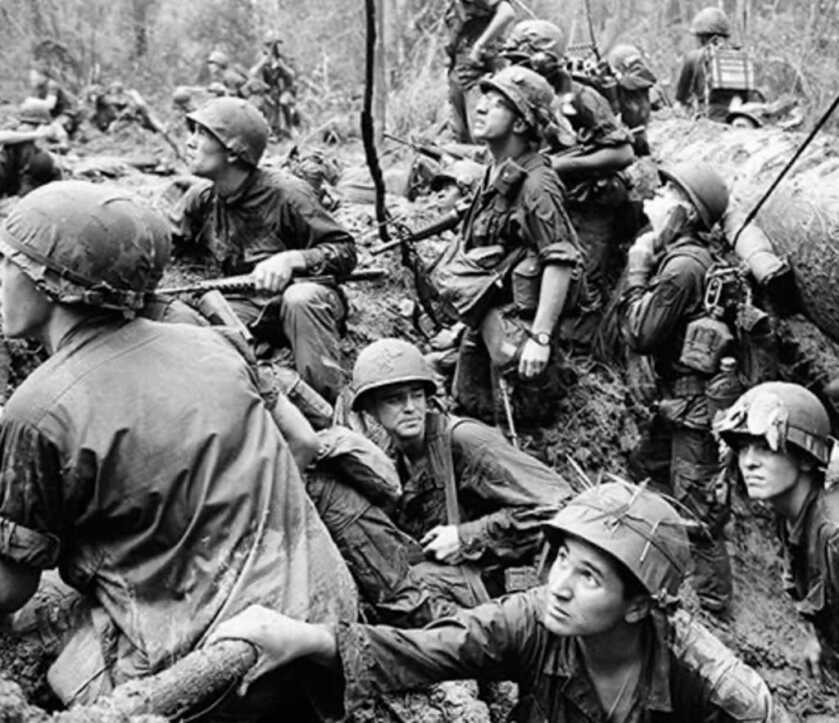
May 4, 1970, was a Monday. The Vietnam War was ripping Southeast Asia apart, while an altogether different war raged across and throughout the American heartland. On the campus of Kent State University in Kent, Ohio, forces representing the Establishment were arrayed against a motley mob of some 2,000 students, hippies, stoners, bikers, and sundry anti-war protestors.
Fertile Ground for Chaos
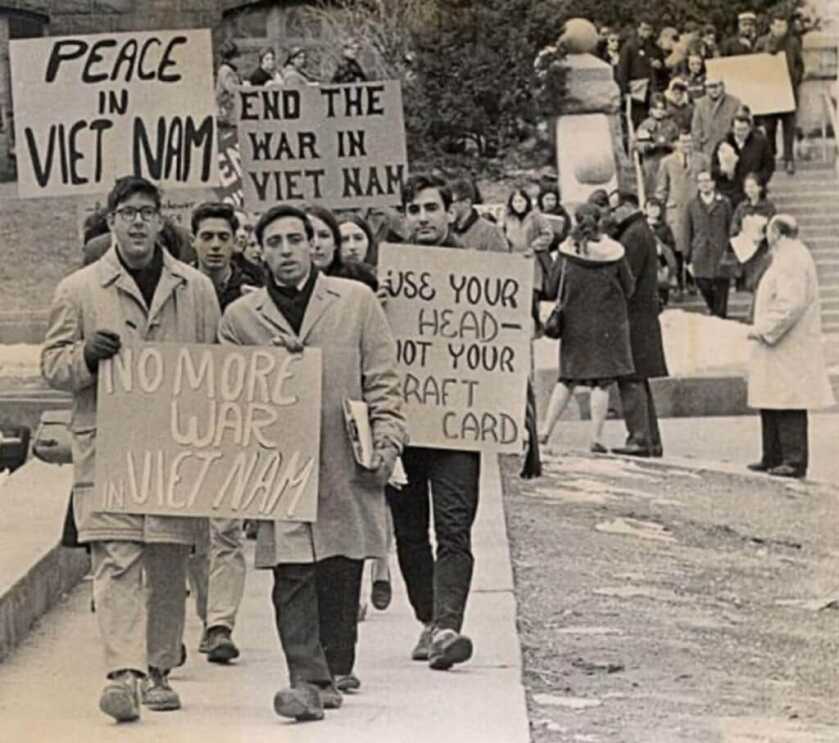
Richard Nixon was two years into a term brought about by his promises to end American involvement in Vietnam. The My Lai Massacre in November of 1969 put an exceptionally ugly face on the conflict, while the pressure of a national draft kept the war personal for American young people. By 1970, student protests at colleges across the country were becoming overtly violent.
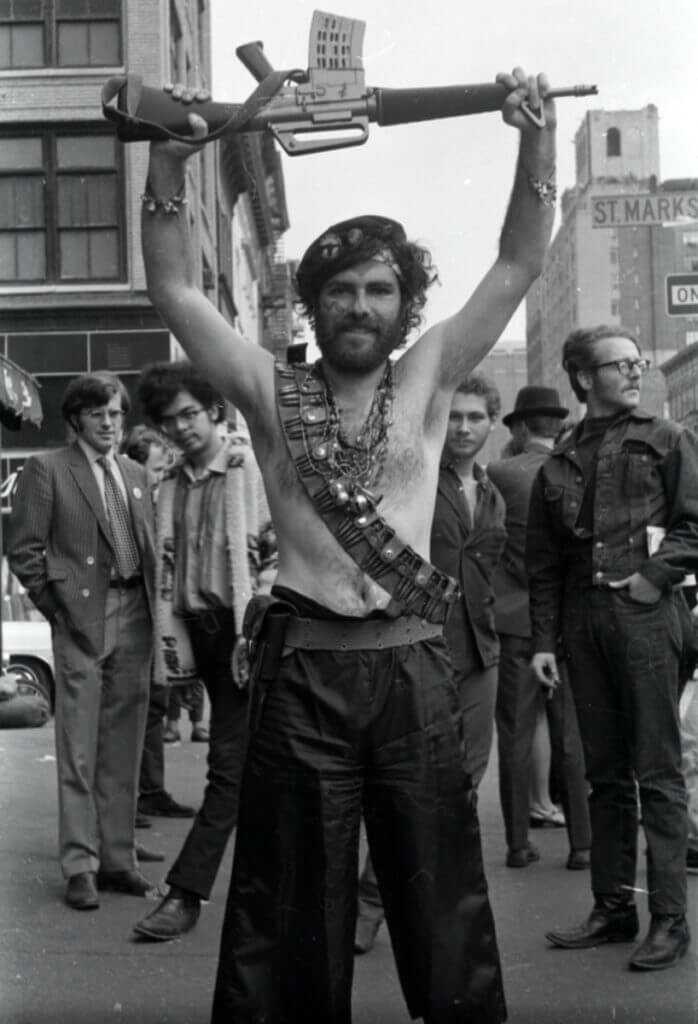
On April 10, Jerry Rubin, the leader of the Youth International Party, announced, “The first part of the Yippie program is to kill your parents. They are the first oppressors.”
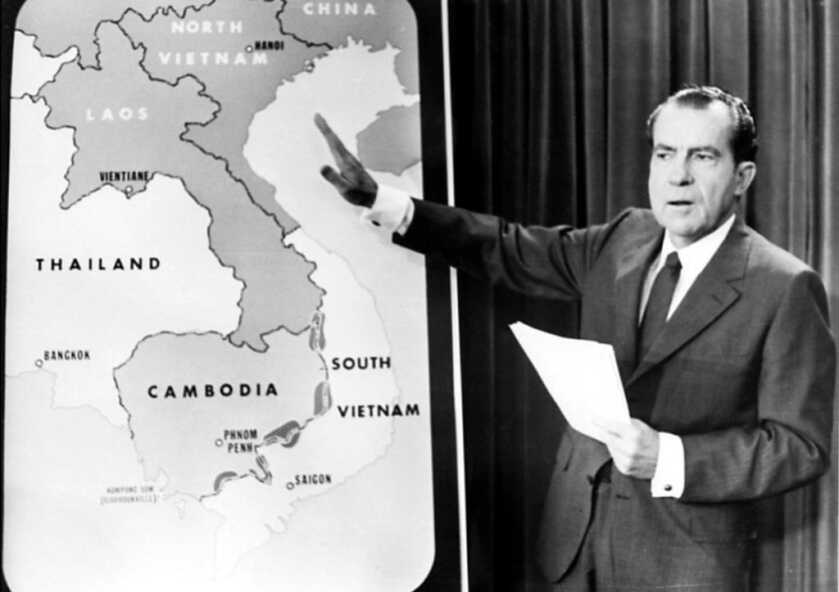
On April 30, President Nixon announced the invasion of Cambodia, a move widely seen as an unwelcome expansion of the conflict in Vietnam. By the first of May, demonstrations were being held both formally and otherwise across the country.
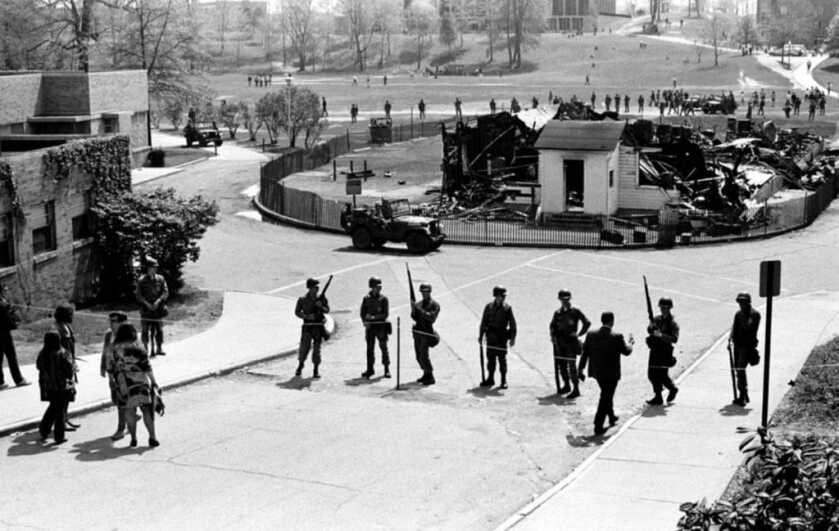
On Friday, May 1 in Kent, Ohio, protesters began vandalizing the downtown area by breaking windows and pelting police cars with beer bottles. Kent Mayor LeRoy Satrom declared a state of emergency and reached out to Ohio Governor Jim Rhodes for support. Governor Rhodes authorized the deployment of two Infantry companies and an Armored Cavalry troop. On the evening of Saturday, May 2, protesters burned the Kent State ROTC building to the ground.
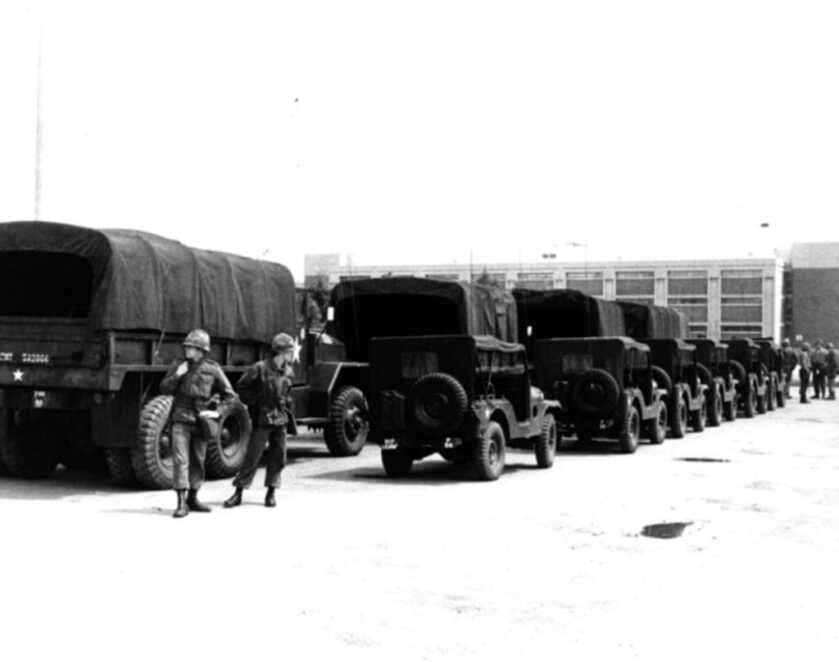
For much of that weekend, chaos reigned across the Kent State campus. Law Enforcement, firefighters, National Guardsmen, and anyone else viewed as being an authority figure were pelted with rocks and bottles. The Guardsmen responded with tear gas. Protesters were commanded to disperse at the point of the bayonet. Though there were a few minor injuries most of the damage was thus far confined to property.
Unleashing Hell

By noon there were violent running encounters between the roughly 2,000 protesters and some 77 National Guard troops armed predominantly with M1 rifles. Windy conditions minimized the effectiveness of tear gas, and protesting students lobbed volleys of rocks at the Guardsmen. The crowds of protesters dispersed and then coalesced fairly randomly in response to the movements of the National Guard troops. Some protesters departed the area, but a great many pursued the main body of troops verbally taunting them and throwing stones.
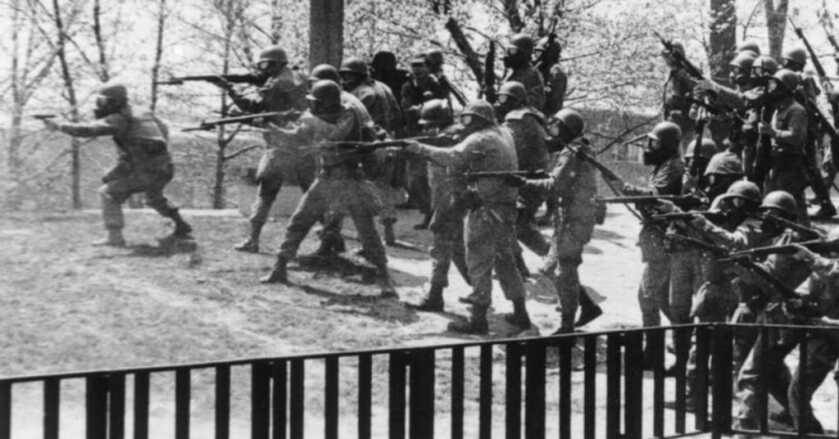
The soldiers moved back toward the campus Commons area. The main body of protesters followed them shouting and throwing rocks. Some of the Guardsmen then stopped, knelt, and trained their rifles on the rowdy mob. Sergeant Myron Pryor then purportedly drew his M1911A1 .45ACP pistol and fired at the crowd. There followed a ragged volley of rifle fire lasting 13 seconds.
The Forensics of the Tragedy
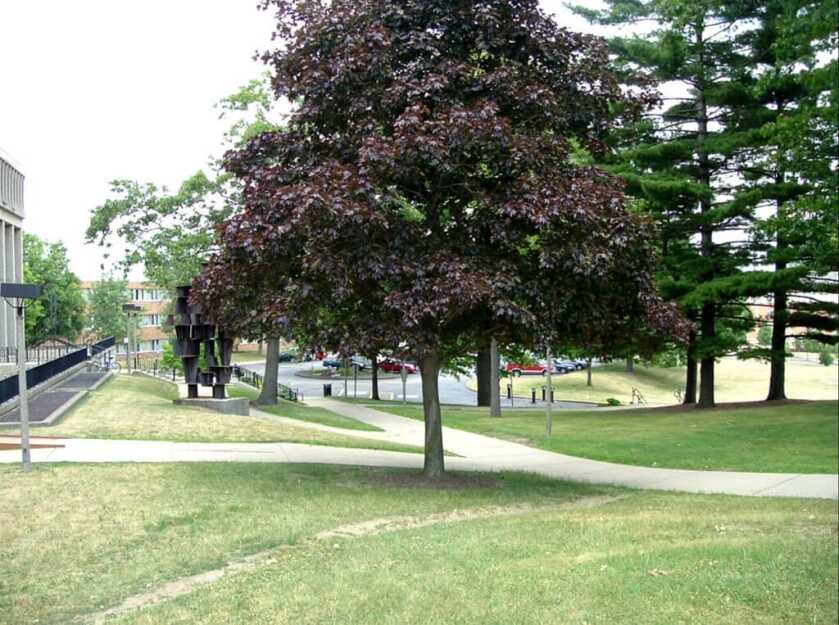
When SGT Pryor first fired his weapon the nearest student to the National Guard formation was 71 feet away. 29 of the 77 Ohio National Guard soldiers later reported having discharged their weapons. Over the course of thirteen seconds, they fired a total of 67 rounds.

Four students were killed and another nine injured. Two of the students, Jeffrey Miller and Allison Krause, were participants in the protest. The other two, William Schroeder and Sandra Scheuer, were walking between classes and not actively involved. Schroeder was actually a member of the Kent State ROTC unit.
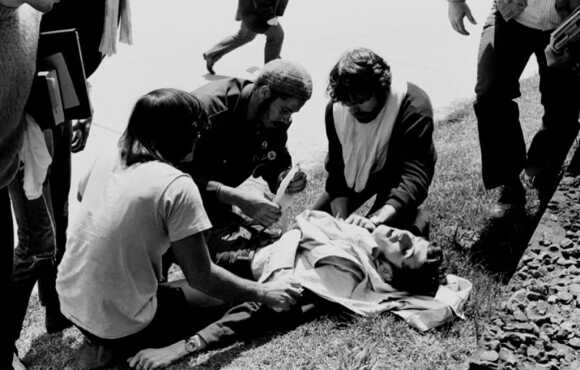
Scheuer was shot through the neck at 120 meters. Schroeder was shot in the chest from a range of 116 meters. Krause was hit in the chest from 105 meters, and Miller was shot in the head at 81 meters.
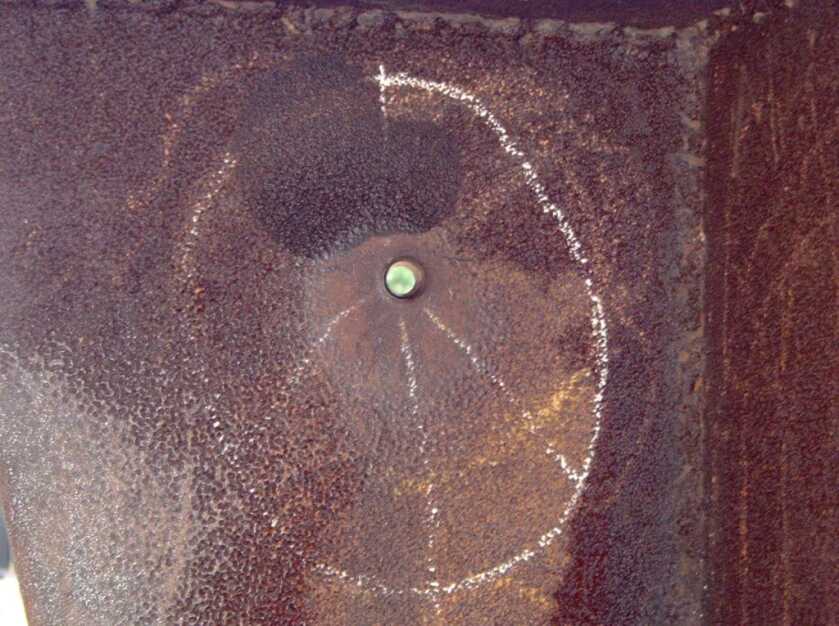
Of the nine protesters who were injured, all were male. Distances ranged from 22 to 230 meters. Dean Kahler was left permanently paralyzed with a spinal cord injury. James Russell was struck in the forehead with birdshot.
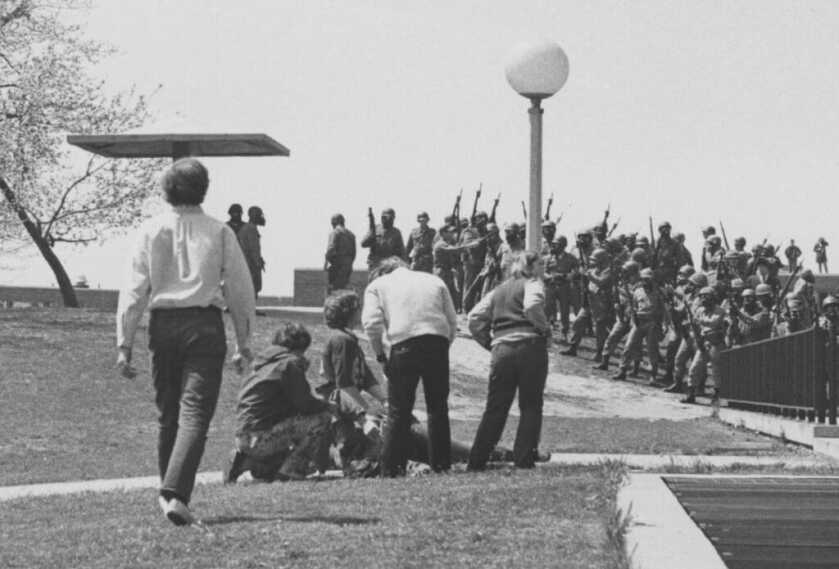
There were allegations that the exchange was precipitated by gunfire against the Guardsmen. The Ohio National Guard commander, General Robert Canterbury, had personally given the order to lock and load rifles prior to the push to disperse the crowds.
The Weapons
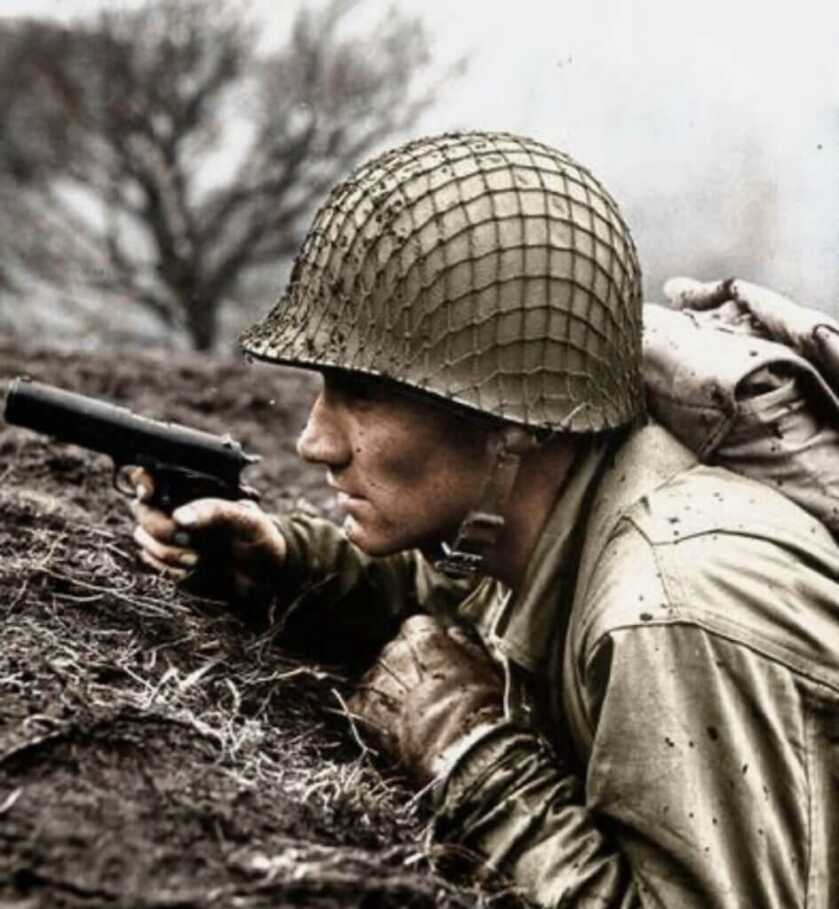
SGT Pryor’s M1911A1 was an evolutionary development of John Moses Browning’s extraordinary M1911. Developed around the beginning of the 20th century, the M1911 was a radically advanced sidearm for its day.
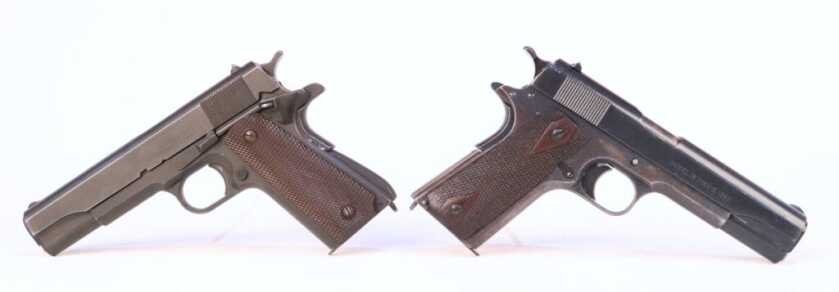
The M1911 saw active service with American forces during WW1. In 1924 the basic design was slightly tweaked into the definitive model that carried US forces through WW2, Korea, and Vietnam. These changes included a longer grip safety spur, simplified grips, a shorter trigger, frame cutouts behind the trigger, an arched mainspring housing, and a handful of lesser adjustments. The resulting pistol was and is reliable, relatively accurate, and undeniably powerful.

The M1 rifle entered service in 1936 and soldiered on as the standard Infantry rifle for the US Army until it was supplanted by the M14 in 1958. A semiautomatic gas-operated design, the M1 was an integral part of the Allied victory during WW2. The weapon obviously remained in service with Army Reserve and National Guard units until the 1970s.

Though bulky and heavy by modern standards, the M1 was a generation more advanced when compared to the bolt-action weapons used by every other major combatant during the Second World War. Given the weapon’s length and rugged construction, it also made for a proper close-quarter tool when equipped with a bayonet. The M1 is rightfully revered by military history enthusiasts as well as those who carried the weapon operationally.

At least one of the Guardsmen involved in the Kent State shooting was carrying a pump-action 12-gauge shotgun. I’ve pored over the period pictures and cannot definitively pick out a shotgun. However, the US Army has used a wide variety of scatterguns operationally over the years. The Remington 870 was in common use at the time. The Winchester 1897 Trench Gun saw service all the way from WW1 up to the 1991 Gulf War.
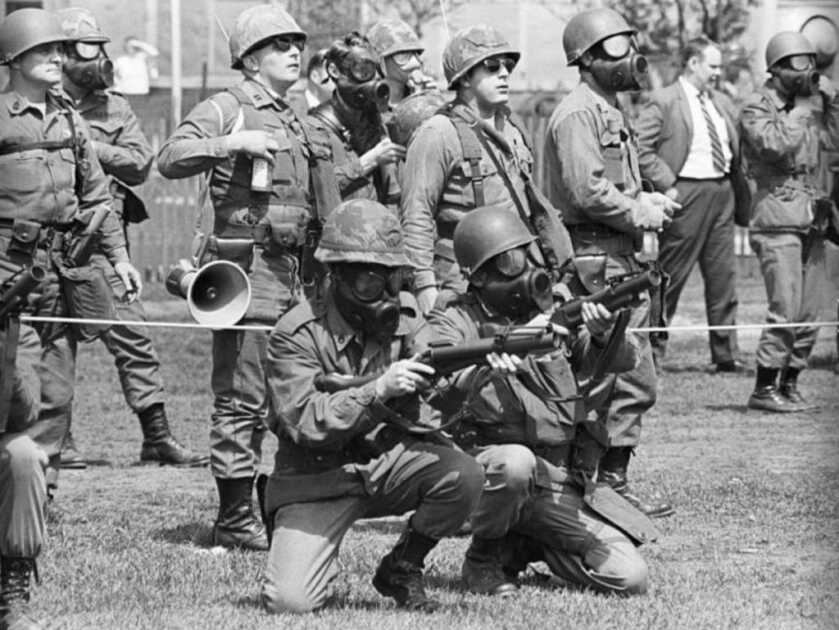
The Ohio National Guardsmen used M79 grenade launchers to throw tear gas canisters. In use from 1961 to the present, the M79 has been variously known as the “Thumper,” the “Bloop Tube,” the “Elephant Gun,” and “Big Ed” by the American troops who wielded it. Australians referred to this beloved weapon as the “Wombat Gun.”

The M79 utilizes the High-Low Propulsion System that minimizes recoil from its 40x46mm grenades. The Mk19 automatic grenade launcher fires 40x53mm grenades that are not interchangeable with those for the M79.

The M79 was largely replaced by the under-barrel M203 which has itself been largely supplanted in US service by the HK M320.
Aftermath
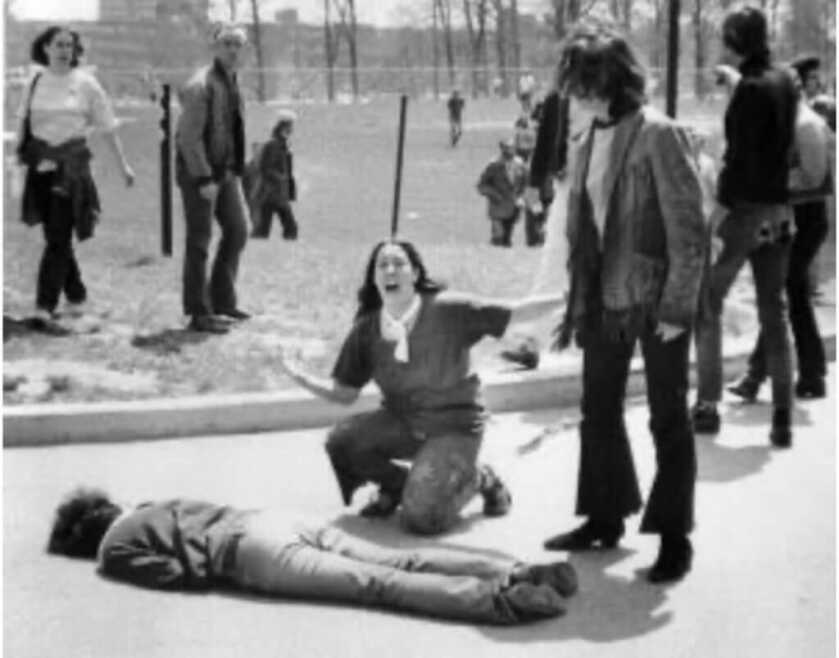
More than anything else a single photograph was taken by John Filo defined the horror of the Kent State shootings. Filo was a photojournalism student at the time and snapped the picture spontaneously. He won the Pulitzer Prize for the image.
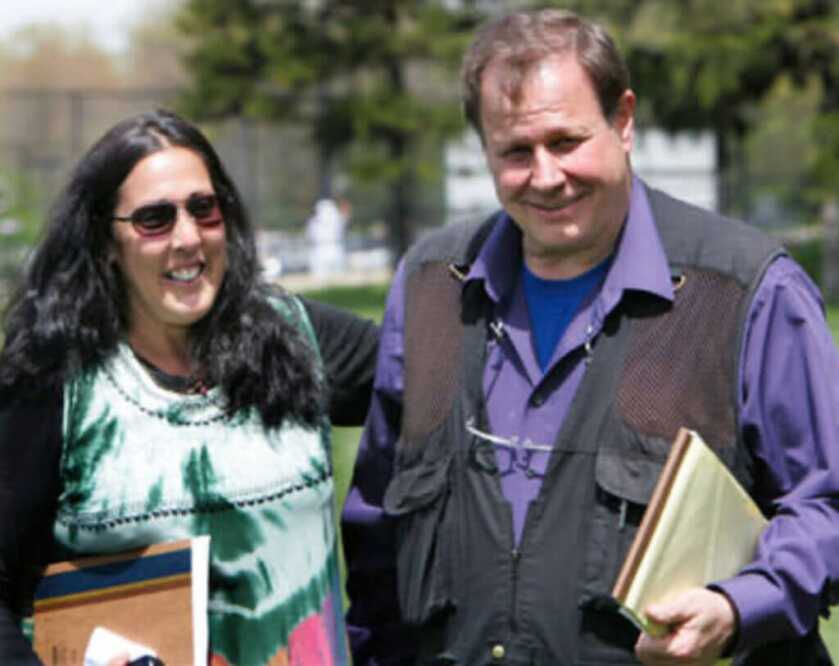
The young lady in the photo is a 14-year-old runaway named Mary Ann Vechio. Vechio was an Italian immigrant who left her home and Westview Junior High School in Opa-Locka, Florida, to illicitly visit the Kent State campus. In the aftermath of the shooting and the photo, Vechio traded her story to a local reporter for a bus ticket to California. Police apprehended her before she could get on the bus and returned the girl to her family. She later sued T-shirt companies for 40% of the profits from shirts featuring her likeness.

As is the case with all such chaotic public events, controversy swirls to this day over the details. Terry Norman was a junior at Kent State at the time of the shootings and was surveilling students and demonstrators at the behest of the campus police and the FBI. He was equipped with a gas mask and was carrying a concealed .38 revolver at the time. Though the details are certainly murky, it has been alleged that Norman discharged his handgun as many as four times some 70 seconds prior to the Guardsmen opening fire with their rifles.

Eyewitness accounts have been conflicting as has been forensic analysis of the scant audio tapes available from the event. However, had Norman actually discharged his weapon in self-defense as has been alleged it would lend credence to the National Guard version of events that they fired in response to gunfire they perceived to be directed at them. The moment was certainly violent and chaotic enough to have been confusing.
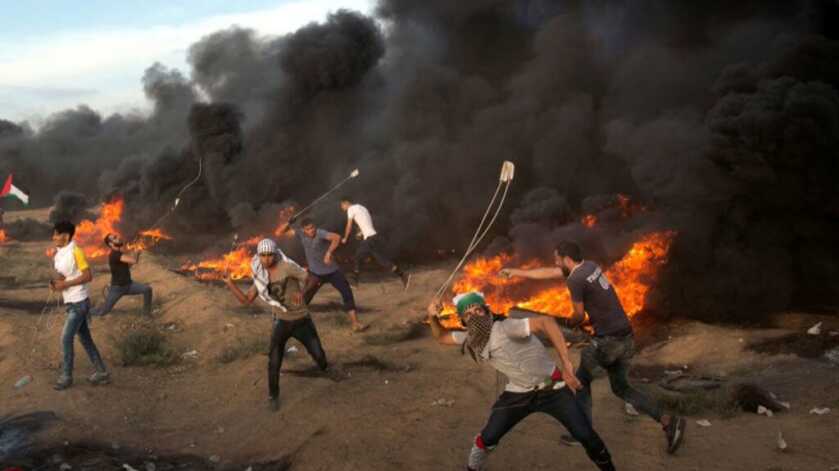
The Kent State shootings ultimately helped catalyze the US withdrawal from Vietnam as well as the downfall of President Richard Nixon. This event also transformed crowd control tactics, tools, and techniques around the world. However, as I researched this sordid event I was inexorably drawn back to a single timeless truth. No matter the righteousness of your cause, whether you are on a college campus, an energized public square, or the Gaza strip, it is seldom wise to throw rocks at guys with guns.
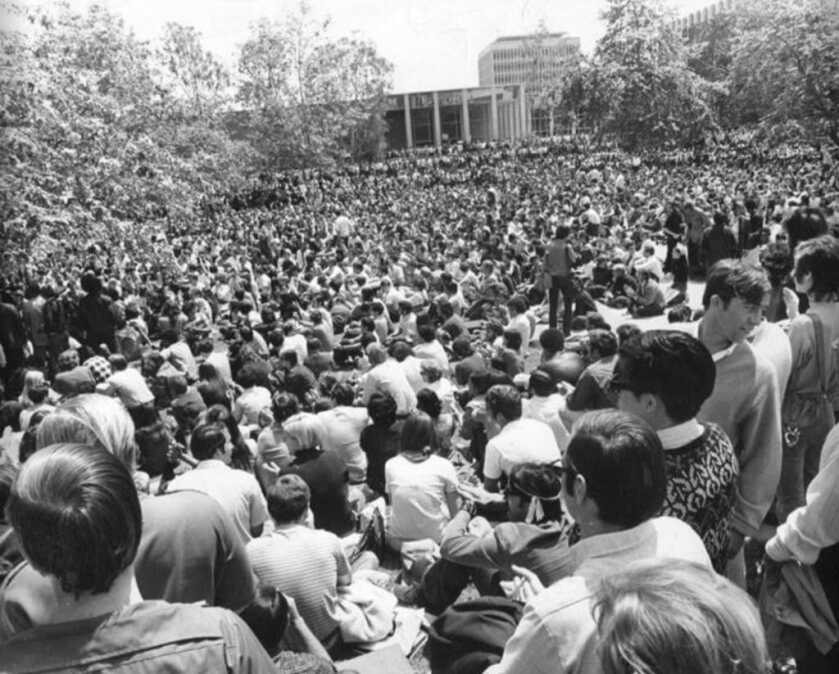
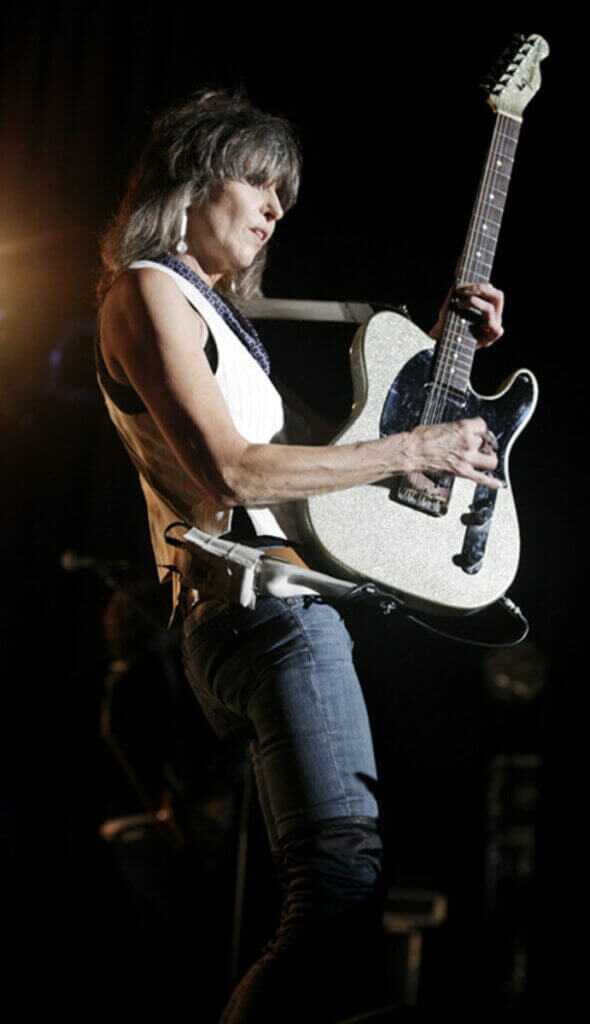



“Of the nine protesters who were injured, all were male. Distances ranged from 22 to 230 meters. Dean Kahler was left permanently paralyzed with a spinal cord injury. James Russell was struck in the forehead with birdshot.”
72 feet. A rock can be thrown that far, so here we have one possibly legitimate target. One.
“Scheuer was shot through the neck at 120 meters. Schroeder was shot in the chest from a range of 116 meters. Krause was hit in the chest from 105 meters, and Miller was shot in the head at 81 meters.”
Not a one of them could have thrown a rock that far. Those poorly trained and led Guardsmen panicked.
Make all the justifications you want, but this was one of the lowest points in US military history.
Lets not forget that the day was hot and the guardsmen had been out of water for quite some time, they also had nothing to eat nor the ability to use the bathroom, They were surrounded by violent college students nd something happened that caused them to start shooting. In the same situation all of you would have reacted the same way.
I was a college student at The University Of South Carolina when Kent State happened. I was also a news reporter for a local radio and TV station. Shortly after Kent State, we learned that the administration planned to cut down all the trees shading the large lawn in front of our student union building. It was a popular gathering place for students to gather, and the bra-less girls playing Frisbee were causing a traffic problem on the city street that bordered the lawn. The state legislators would cruse the area ogling the chicks and go back to the State House and complain about our low morals. So the administration thought that by cutting all the trees and paving the lawn we would find another place to gather. A few dozen students decided to protest the tree removal and made some signs. The plan was to silently march around the horseshoe near an awards ceremony where the Board Of Directors were in attendance. Thinking it might make a good story, I watched from a distance. Apparently there was a spy in the group, because before they ever got near the ceremony a hidden platoon of National Guard descended on them with backpack teargas cannons. Not only was it illegal, it was totally unproportional to any perceived threat. Typical to what I saw in the weeks that followed, the plan was ill conceived. The wind blew the teargas toward the ceremony and the Directors retreated to the nearby administration building. Students from a nearby dormitory got gassed in their rooms and boiled into the horseshoe, demanding to know what was going on. The directors barricaded themselves in the admin building and refused to discuss what they had done for no reason. Someone decided to smoke them out and set a fire, which eventually leveled the building and started a several week siege on campus between students and the Guard, local police and Sheriffs’ Deputies. That no one died was a miracle. Marshal law, tanks and an armed standoff ensued. The “law” ringed the giant campus but never managed to enter. The students erected barricades for their own protection and only responded when some idiot Guardsman decided to lob a teargas grande toward a dorm. As an accredited news reporter, I had free access to what was going on, and I saw countless abuses of power by the “authorities” being met with force by students who had no agenda whatsoever but also had no intention of being abused by people in uniforms who thought they were justified in teaching us a lesson. The standoff ended when final exams were cancelled and we all just went home. There were no winners, but the cowardly administration, clueless governor and morons in uniforms clearly caused the riots, not the students. As we have seen over and over recently, just because someone is wearing a uniform doesn’t mean they are acting legally and just because a person is in the area doesn’t mean they are a rioter. Two of those killed at Kent State were just on their way to class. Regardless, there is little real threat to armed military in riot gear from rocks and bottles. It certainly does not begin to justify the mindless shooting into a crowd with rifles. There is absolutely no excuse for using deadly force in such a totally random way as to fire blindly into a crowd just because someone else burned a building on a different day somewhere else.
Which of the students that were killed or wounded were responsible for burning or destroying or for throwing rocks and/or bottles at the NG or police? Is the death penalty appropriate for assault or arson? How were they identified? Which judge and which jury tried them and pronounced judgement and penalty? Those charged with enforcing the law should abide by the lawful procedures.
True, but you were not there nor have you probably ever been in a situation where mobs of people were perpetrating violence against you.
My Lai occurred in May 1968, not November 1969.
If I may point out a fairly major distinction that extends beyond mere semantics: “protesters” did not burn down the ROTC building or throw rocks at the Guard unit.
Once a mob engages in that behavior, they cease to be “protesters” and become criminals. The distinction between “protester” and arsonist/rioter/looter/criminal is an important one.
Very true. Just like the current mob of degenerates burning police cars and stations and looting stors are not protesters, they are criminals.
Will,
Outstanding short story as always. You have a gift to succinctly relate a complex story. Thank you.
Actions taken in mayhem should not be judged in the comfort and safety of an afterthought. Just a few mitigating factors if you please. All death is sad. All violence is bad. Three ounces of bottle or rock thrown from a short distance at average baseball velocities produce enough impact energy to kill and injure—as history has repeatedly established. That means the first rock makes it a lethal force encounter to govern any further actions. The lesson here is “obey the law, do as police say once the law is broken” and “don’t bring rocks and bottles to a gunfight.” The same is true today as in 1970 or any time before and after. There is a right to free speech and protest; there is no right to riot. Once the law is broken by violence—burning, rock throwing, assault on police—the protest is a riot and rioting is against the law. All who remain once the skirmish line is assumed by police agencies are breaking the law. Little of this has changed since Kent State—just the subject matter really. Thanks for the reminder, Will. Well done.
The first rule of firearms my father taught me – Never point a firearm at anything you don’t intend to kill. Rocks vs. Firearms? Shameful behavior of the troops at Kent State that day. They demonstrated a lack of discretion and training.
The untested should never sit in judgement of the invested. You father should have taught you be a bit more reticent when speaking in public.
A citizen has every right to sit in judgement of the actions of government employees. Your father should have taught you that.
Bull-oney.
The attacking rioters had it coming and deserved what they got.
Parallels exist to today’s rioters, who are more violent and destructive than their 60’s predecessors.
BTW: rioting, looting, burning, assaulting others, blocking roads, etc., is NOT free speech.
a rock properly targeted and striking the head at the speed attained by a average thrower is every bit as lethal as a bullet.if you pick up a fist sized stone to hurl it at me ill do my best to kill you first.ill be sad but alive.
“Protesting” (without violence) is a 1st Amendment right! Illegal actions resulting in Arson, Rioting, Assaults, Vandalism, and Disorderly Conduct, et al, cannot be condoned or rationalized as legitimate “Protests”! Orders were given to disband the riotous gatherings on campus since the “protests” became disorderly and violent to Guardsmen, Police, bystanders and students–1st warning. Then tear gas was shot–that was a huge 2nd warning to disband and LEAVE the area. That is what happened on May 4, 1970 after deadly rocks, bottles, etc. were thrown. Then, Guardsmen, such as Sgt. Pryor, fired their weapons to protect their lives and those of their fellow Guardsmen from perceived DEADLY VIOLENCE directed at them. What happened was sad for many, including the Guardsmen, the innocent passers-by and naive fun-loving participants.
When it comes to government employees, including National Guard troops, “perceived” should never be an excuse for them to use violence. The NG troops fired into a crowd with no identified target who was a threat. These were Americans they were shooting at, not enemy troops on a battle field.
These “Americans” were domestic enemies that were engaging in violent attacks in support of our enemies overseas with whom we were in armed conflict. They got a small measure of what they deserved, and to them I say “good riddance”.
Troubled times bring events that have terrible results.
First of all, with the US getting out of the war in Vietnam, evil was allowed to take its toll of millions of Humans in South Vietnam, because of that action. I’m sure everyone protesting has given that some though at sometime in their life.
Second: Like today, people are protesting, yet those who fail to understand that once you deprive the basic rights of another individual in that process, you open up a chain of events that can turn sour fast.
The lesson to learn is; in ones method of protest, any offensive action has the high possibility of being met with a reactive force of equal or of a greater reaction. A reasonable response by those known as Human.
The event at Kent State, as tragic as it was in retrospect, could have been avoided by making the message as clear as possible without violating the rights of others or using violent means. When you do so, it is no longer a protest, but a battle of different beliefs.
Ones actions must be considered and there results expected, it is how those results are perceived by the masses, which will truly determine the outcome of that action. The problem now in today’s times, is that those with limited knowledge run a high possibility of being crushed in time regarding their actions. The public over all is more in tune with the intentions of those who are trying to change the status quo to something that is known and has been proven to be a lie. Yet the hearts of men and women need to be changed, not by social re-engineering, but by ones submission to the truth that is, was and will ever be.
It is the individuals choice between right and wrong, that will truly determine the battle before us, a battle that has been with us since the beginning. Choose well, for the peace of this world is at stake!
I was a student in NYC during that time. The student lounge was a meeting place where our professors instigated the students into opposing the war. They disparaged our nation openly. As a Cuban refugee, I took offense at their disloyalty. I told them they should be sent to Cuba and see what real tyranny was like. Naturally, I was not popular with them. I had to be meticulous in my studies and on my exams so as not to allow them an opportunity to flunk me. It is the teachers of today who have infected our youth with their anti-American ideals. That is where you start if you wish to eliminate the disease.
Absolutely ” Gulf -Delta ” right , Mr. Ramos !
I cannot agree with you more , sir .
The “professors ” you speak of , had never been to Cuba , and had NO idea
of that which they preached . The same situation we see today !
These insurrectionists should see the ” Utopias ” they advocate , prior
to backing them , & attempting to speak for all of us .
Disgraceful , they are !
I guess I’m the stupidest of the stupid. Had a draft card but enlisted. The Vietnam war didnt tear this country apart.Aside for some domestic communists nobody cared about that stinkin shithole.The draft tore this country apart. The Statists and Globalists learned thire lessons well from the draft. Which is why they’ve gotten away with 30 years of running amok setting the world on fire. Now call up the draft and yank little Jimmy and yes, Jill out of junior college and watch the replay of the 60’s.
The students were there to protest an unjust war (their Constitutional right) which we had no business being involved in. Their choice was to be shot by north Vietnamese or US soldiers at home. All they really wanted to do was get a college education. Articles like this are nonsense and help promote similar civil unrest and injustice in the future…like now with Trumpasaurus Wrecks at the helm.
The cowards were there to avoid the inconvenience of being drafted. Too bad 400 of hem weren’t killed, instead of four.
And responses like yours are total nonsense.
I can’t imagine what must go on in your head if you truly believe that an ARTICLE like this is going to “promote” such acts.
So, are YOU telling us that YOU are so influenced by these things that it would inspire you to such acts?
If so, you really aren’t too bright.
In fact, I see little if ANY logic or reasoning in your post, just a chance to vent your very obvious T.D.S. to the world.
What a waste of time and space you are.
What specifically did you find nonsensical?
Bullshit!
This is your opinion. We all know what they say about opinions. You don’t like Trump. Nobody else cares. These pieces by Dr. Dabbs are interesting historical articles about things that happened involving different types of firearms. Nobody cares about your political beliefs.
You have the right to peaceably assemble. You don’t have the right to riot.
@DCA whatever you braindead libtard squawker.
Throwing rocks at their fellow citizens is not “protest,” it is aggravated assault in most places. Burning down buildings is also not “protest,” its arson, among other crimes.
Whether the Vietnam was or was not “unjust” is entirely a matter of opinion. If they didn’t like it they should have voted for a presidential candidate who would get us out of Vietnam. I find it ironic that two years after Kent State the peacenik Democrat candidate George McGovern lost in the largest electoral landslide in history up to that time. He lost the popular vote too by 18 million votes and only won one state and the District of Columbia. Where were these students on Election Day?
The truth, although it will likely make little impact on you, is that today we would define their acts as “domestic terrorism” and like their latter day Antifa fascist cousins and their BLM Marxist/Communist cousins, who have also committed acts of domestic terrorism (look up the definition, I’m right) they should have all been arrested and punished. Violent acts are NOT protest. Let’s get that straight once and for all. Anyone who suggests that is either ignorant or stupid, perhaps both. And if they were students then perhaps they should have shut up and been in class learning rather than running around trying to teach everyone else by committing acts of domestic terrorism.
This was the beging of the end of Americia. The youth of the time broke the rules & got away with it. It has spiraled out of control ever since. Law can be broken if it for “a cause”. This is why the Americian youth of today feel they can do what they want when they want with out recorse. This is when the “me generation” started.
Remember are pledge ” To the republic” (not the democrat) !
The government broke the rules first by sending troops to the other side of the world to fight in a war that had nothing to do with defending the American people.
For educated people you would think that rocks and bottles against rifles might be a good reason to give pause, but it is obvious that they were wanting to hurt and kill those guardsmen and take their rifles so they could continue there fight against the establishment. I figure that if the students got the upper hand there would have been a lot of dead people by their hands! Any guilty parties in this would be the ones who instigated the students into rioting!!!
Great article Will. Very informative. Puts perspective on our current situation.
A couple of points. Similar to today I don’t like to describe these violent rioters and criminal thugs as “protesters.” Protesters don’t commit violent acts, burn buildings and threaten their fellow citizens or the forces of law and order. They may be protesting something but when they cross the line to violence and vandalism they become something else whether they like it or not.
Also, this incident didn’t start the demise of Richard Nixon. It served as yet another catalyst to push America out of Vietnam, but there were many of those and Nixon was headed in that direction anyway. Cambodia notwithstanding, we were leaving and the invasion was just a temporary detour to better position us to leave and prop up our ally in South Vietnam. In 1972 Nixon scored a resounding victory, an electoral and popular landslide against the inept Democrat peacenik George McGovern, and neither the invasion of Cambodia nor Kent State had any meaningful impact on him. His demise was entirely self inflicted and stemmed from his own paranoia and poor judgment. The Watergate mess that drove him from office was of his own making, a creature mostly of his personal demons. Had Watergate not happened it is likely he would have served out the rest of his second term and gone down in history as the republican who got us out of Vietnam and opened up Communist China and nothing more. Of course the long term implications and wisdom of “opening China to the world” are still reverberating across the globe today and whether Nixon’s actions there were a good thing or otherwise remains to be seen.
Thanks again for yet another very interesting piece.
Perhaps the author should have spoken with the students there that day as I did. A completely different perspective.
Can you share that perspective; I’d truly like to hear it.
“Students,” by definition, are in place to learn. Not to teach.